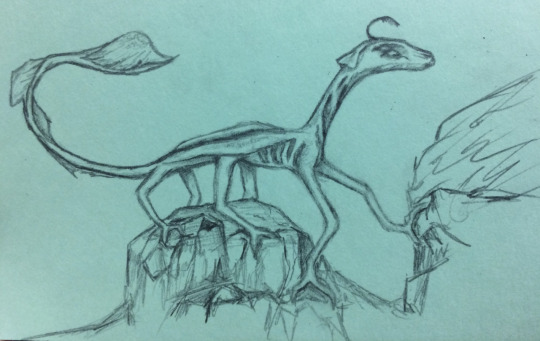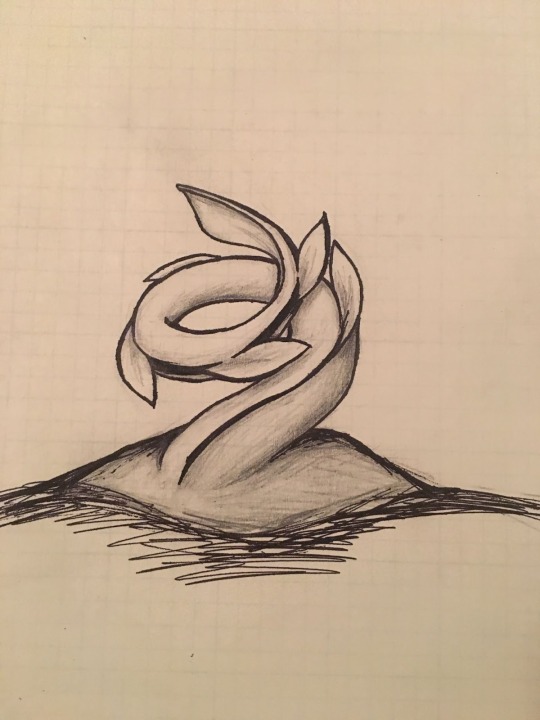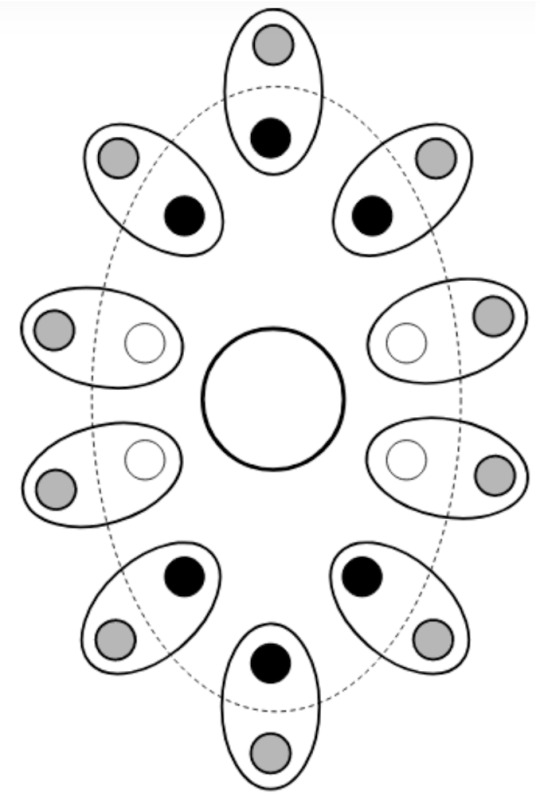Text
I'sola - Physical Descriptions/Visuals
Image 1 (Below). Were you to catch them awake, the I’sola would appear to be six-legged dragons, with stingray wings and green leaves littering their whip-like tail.
I’sola are generally a dark black-blue, with strips of phosphorescent yellow dug into their skin, winding in unique patterns for each one you meet, but always with brightly shining strips cut horizontally up their long necks.
But let's look a little closer.

See the Google Doc with additional formatting and higher quality images Here.
Image 2 (Below, Left). Their heads, snake-like in construction, have no mouth to speak of and barely-visible strips of mesh-like material indented into the sides of their snout in place of nostrils. Their four eyes more than make up for this visual lack. Two of them, blank and yellow, are nestled into each other on each side of their head, so large as to take up a near third of where their skulls would sit.
[Though these antennae are nearly identical between males and females of the species, they provide very different functions - the males’ giving off pollen, and the females’ collecting it.]
Just behind the antenna is a soft flexible frill, laying flat back against the I’sola’s neck. It, like the rest of the I’sola’s body, is mostly blue with patterns of yellow. This frill is slightly shaped like a crest of a triceratops, and it - along with the I’sola’s neck stripes and antennae - are used extensively in communication.


Image 3 (Above, Right). Here you can see the front view of an I’sola, the way that the neck stripes seem like carved wounds into their neck, and how their legs sprout from beneath their wings.
Image 4 (Below, Left). Though these large creatures seem like they would need a great amount of physical support, their torsos are not solid at all, but seem to be branches forming a facsimile of ribs, protecting something vital inside. That ‘something vital’ seems only to be present in half of the population: two large seeds nestled within inner roots. See [Life Cycle] post (not yet linked). They do not seem to breathe, and they make almost no sound as they walk, sometimes even using the reduced gravity of their home world to glide along with their stingray-like wings.


Each of their long spindly legs seem to be made up of bark-like segments, split at the joints. They each have the same general construction, but the two forelegs contain an extra joint in both the leg and the fingers. Their limbs each have a foot with three spread toes ending in wide shovel-like nails. In addition, the toes on the back four legs are slightly more flexible to allow for an easier grip as they navigate their rocky home.
Image 5, 6 (Above, Right). When moving about, they walk on slightly-raised toes, protecting a hole placed at the center of the bottom of their feet. When they lay down to sleep, they spread their limbs out around them and their toes out wide and flat, revealing this opening and allowing their roots to extend outward. These roots can then dig deep into the soil to collect nutrients while they rest.
Image 7 (Below, Left). As plant-based creatures, they need sunlight, water, carbon dioxide, and additional nutrients from the ground soil around the rivers to survive. I’sola usually gather what they need during the Ring, sleeping near the rivers with leaves pointed towards the Ring in the sky and looking like large, fern-covered rocks or vines spiraling up toward the sky. Nearly three quarters of their days are spent in this state.


Image 8 (Right). Their Life Cycle will be discussed later on, but here you can see a depiction of a young I’sola, growing out of the ground before it has gained mobility. I add this here to give a better understanding of how their tails might look.
#humans are weird#humans are space australians#humans are strange#I'sola#I'solan Lore Building#original species#aliens#aliens and humans#original fiction#my art#art#sketch#eyes#leaves#creatures#plants#physical description#alt text#alien species#Crash Landing#world building#biology#original story#image description#visuals#links
25 notes
·
View notes
Text
I'solan Solar System - Planet Descriptions and System Diagrams, Visuals
Visual Description of First Landing
“Surrounded by black obsidian, lifeless, and a small river cuts through the rock on your right, leaving smooth edges on its banks. It’s the only sound. A ways off, you can see green plants of odd shapes and various sizes..(wind)(light).. It’s brighter than night should be and too dark for day; everything has an odd (stygian) blue cast to it. In the sky, a silver band is backlit by an endless number of stars.”
Additional Descriptors: Dusk, before sunrise/sunset, Antarctica autumn, Storms, Fog, Eclipse, Caves, Silver curtain

See the Google Doc with additional formatting Here.
The I’sola live on one of a set of rotating twin planets (a binary planet system). These planets have opposite and interlocking magnetic poles, which allow them to stay as close as they are without incident - gravity pulling them together, magnetism repelling them, and inertia helping to keep them apart. Hoset and Ma’al, or Hephaestus and Pan, share both an atmosphere composed of oxygen and carbon dioxide (percentages varying throughout the year) and a glass ring made of shattered meteors that orbits the twin system. The planets themselves are vastly different from one another.
Hoset/Hephaestus
Hoset is the planet that is unable to support life. Throughout the year (623 days), carbon and other material falls to Hoset in the way of meteors. These materials build up until the system gets close enough to the sun on its elliptical orbit and Hoset lights on fire for a fairly short burning season (44 days), burning out all of the oxygen in the atmosphere and replenishing the carbon dioxide necessary for the I’sola that live on Ma’al. Hoset constantly faces the sun and rotates at about the same speed as Ma’al.
Ma’al/Pan
Ma’al is a black planet with large, fast-moving rivers running to the poles. As the ash from Hoset floats over and coalesces into these rivers and fertilizes much of the planet, it ends up at the poles where enormous geysers shoot it up into space, sometimes temporarily creating dark clouds in the sky. There are two times of Ma’al’s rotation cycle: the Ring and the Eclipse. The Ring lasts for three quarters of the rotation and refers to what we would think of as nighttime, with a silver band of light standing out against the night sky, no moon to speak of. The Eclipse refers to Hoset standing out as a black circle in the sky, covering the sun but leaving a surrounding fiery afterimage, the ring fading into black as it draws away. During burning seasons, Hoset simply looks like a large sun. Each rotation lasts 31.5 Earth hours though the I’sola speak of time in terms of rotational degrees - 0°/360° being the center of the eclipse “Ban” (meaning halfway) and 180° being Midring. “Planetfall” is when many I’sola go to rest, looking like an inverted sunset/sunrise.


Image 1 (Left): A diagram of the I’solan Solar System, with its binary planets: Hoset and Ma’al. The gray planet is Ma’al, consistently the furthest from the sun - the I’sola live here. Hoset is depicted as white, in its burning seasons, and black when it sits as a dreary, dead lump of rock. Hoset’s burning seasons occur when the planetary orbit is closest to the sun; it lights on fire and burns for two seasons throughout the year. The oval around the two planets depicts the glass ring that Hoset and Ma’al share. It is made of melted bits of meteors and it refracts sunlight around to the back of Ma’al even during its ‘night’.
Image 2 (Right): A diagram of the day cycle of Ma’al, as it relates to Hoset. Ma’al (in gray) rotates clockwise as depicted above. Between 45°-90°, Hoset is hazy and slightly more distant in the sky, the sun more blinding than eclipsed by the dead planet, and the ring slowly fades in or out with the darkness. At 0°/Ban, the center of the eclipse, there is a complete solar eclipse, a void backlit by the sun. During the burning seasons, Hoset looks fiery red.

Image 3 (Above): A depiction of the I’solan written calendar. The ring rotates vertically around the binary planet system, and the days can be tracked by the angle of it in the sky.
#I'sola#I'solan Landings Lore#Crash Landing#worldbuilding#humans are space australians#humans are space orcs#humans are strange#humans are weird#original fiction#science#sci fi#solar system#space#lore#pseudoscience#art#diagrams#day cycle#my art#Ma'al#Hoset#hephaestus#Pan#Description#My writing#snippets
24 notes
·
View notes
Text
Universal Foundations - What you just have to accept about the universe & setting.
(Humanity, I'sola, Luck, Species History)
See the Google Doc with additional formatting Here.
Humanity
Humanity has advanced to the point of space travel.
Wormholes exist but are not well documented.
I’sola
An alien species called I’sola exist in a far off place in the universe.
They live on one planet of a binary (twin) planet system, which rotate around each other.
The system is in locked rotation with the sun, with one planet (Hoset), always being closest to the sun.
The I’sola live on the planet furthest from the sun (Ma’al).
The two planets share both an atmosphere and a glass ring of melted meteors.
When their orbit takes them close to the sun, Hoset ignites.
The planet burns constantly for half the year, split into 2 burning seasons.
The I’sola are plant-like creatures.
They breathe in Carbon Dioxide and breathe out Oxygen.
The I’sola have 2 genders of seed-bearers and fertilizers, though there are no romantic pairings.
The ‘female’ will leave behind two seeds that have grown within her body when she dies.
The ‘male’ will separate the two seeds far enough apart that they will have room to take root, sprout, grow through a plant stage, and eventually into fully mobile creatures before they also die.
Side Note: The ‘male’ is not technically the fertilizer of the eggs. All ‘males’ give off the equivalent of pollen through the air constantly, collected by the ‘antennae’ at the top of the mother’s head.
The DNA of the seeds take in various parts of DNA and mutate throughout the mother’s life.
With both parents dead, the seedlings are raised by the elders of the community.
Because of this method of altruistic reproduction, the population of the I’sola never changes.
The I’sola believe in reincarnation, and that they are simply a reimagining of the same set of souls for all of conceivable time.
Luck
‘Good’ and ‘Bad’ luck are fundamental (aspects) like north and south poles.
Another term/way of thinking about it is the tendency of an object to dissolve/fall apart in certain ways (i.e. entropy).
Luck can therefore be ‘balanced’.
Humanity as a species is ‘bad’ luck, and the I’sola are ‘good’ luck.
The main characters in the story represent ‘good’ luck for the humans and ‘bad’ luck for the I’sola.
Hoset, the burning planet, is ‘bad’ luck, and Ma’al, the planet with life, is ‘good’ luck.
Species History
The I’sola can control the direction of entropy or ‘luck’.
The prior sentient species, (a race similar to ducks), could also control entropy.
They used it to collect a large amount of ‘bad’ luck in one place for the sake of a scientific experiment.
The ‘bad’ luck conglomeration exploded, killing the entirety of the planet but for the plant ancestors of the I’sola buried deep in the ground.
The I’sola are now the only living creatures on the planet.
#Universal Foundations#I'sola#Lore#Worldbuilding#Links#Introduction#I'solan Landings#Crash Landing#humans are space australians#humans are strange#humans are space orcs#humans are weird#alien oc#original characters#pseudoscience#sci fi
43 notes
·
View notes
Text
Hi, I’m Sun! (She/Her)
This blog is for my original book that I am working on, initially inspired by humans are weird posts but long since mutated and expanded lol.
Here are some links to help navigate the lore and characters a bit! Each one will take you to a more detailed post with google doc versions and additional links as needed/the blog is expanded. You can also navigate using the tags on this pinned post.
Questions Welcome - Please let me know if something seems unclear!
Introduction
Universal Foundations - What you just have to accept about the universe & setting. (Humanity, I'sola, Luck, Species History)
I'solan Solar System - Planet Descriptions and System Diagrams, Visuals
I’sola - Physical Descriptions, Visuals, Some Biology
All Links/Categories below are WIP and unposted.
Problems/Plot Drivers (Spoiler Free!) - [Problems/Plot Drivers document with Solutions Included (Many Many Spoilers)
General
Plot
Themes
Scenes/Snippets
Art
DND Campaign Info
I’sola (original alien species)
Solar System & Physics
Biology
Writing & Language Systems
Science & Scientific History
Religion & Culture
Characters
Humans
Individual Characters
Group Relationships/History
Please feel free to send an ask! If you poke at a piece of the plot or characters, it’ll make me get some more writing done lmao and help me in fleshing things out.
#I'sola#Pinned Post#Navigation#Links#humans are space orcs#humans are strange#humans are weird#alien oc#original Characters#Universal Foundations#I'solan Landings Lore#Crash Landing#worldbuilding
5 notes
·
View notes